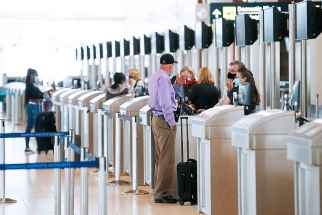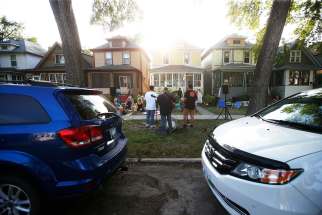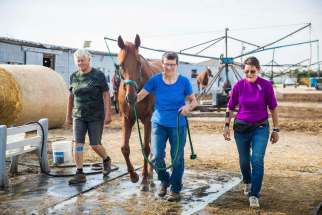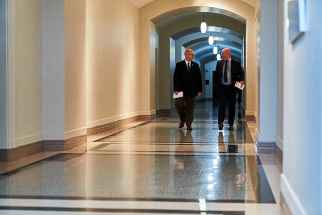Air travel continues to stir COVID-19 anxiety, caseload
Read this article for free:
or
Already have an account? Log in here »
To continue reading, please subscribe:
Monthly Digital Subscription
$0 for the first 4 weeks*
- Enjoy unlimited reading on winnipegfreepress.com
- Read the E-Edition, our digital replica newspaper
- Access News Break, our award-winning app
- Play interactive puzzles
*No charge for 4 weeks then price increases to the regular rate of $19.00 plus GST every four weeks. Offer available to new and qualified returning subscribers only. Cancel any time.
Monthly Digital Subscription
$4.75/week*
- Enjoy unlimited reading on winnipegfreepress.com
- Read the E-Edition, our digital replica newspaper
- Access News Break, our award-winning app
- Play interactive puzzles
*Billed as $19 plus GST every four weeks. Cancel any time.
To continue reading, please subscribe:
Add Free Press access to your Brandon Sun subscription for only an additional
$1 for the first 4 weeks*
*Your next subscription payment will increase by $1.00 and you will be charged $16.99 plus GST for four weeks. After four weeks, your payment will increase to $23.99 plus GST every four weeks.
Read unlimited articles for free today:
or
Already have an account? Log in here »
Hey there, time traveller!
This article was published 14/08/2020 (1948 days ago), so information in it may no longer be current.
By now, anyone who has heard about COVID-19 has also heard the world was unprepared to respond to a pandemic. Check that: fully, completely, ridiculously unprepared.
Basic medical equipment and supplies were not stockpiled in sufficient quantities. Logistical plans for the operation of essential services, such as hospitals, were not in place.
However, of all the shortcomings, the inability to make air travel safer may stand out.

The coronavirus did not spread by shipping container, prevailing winds or ocean currents; the virus was a stowaway, carried by air travellers as they zipped across the globe. The phenomenon was aided significantly by the fact nobody knew exactly when and how to control air travel to contain the virus.
Although it may seem remarkable, even now governments and corporations are struggling to introduce consistent measures to ensure travellers do not inadvertently spark a new cluster of COVID-19.
Airlines and airports have introduced pandemic safety measures: capacities were, at first, severely limited; passengers are required to wear non-medical face masks in airports and on-board; many airports now do temperature checks and other screening measures before passengers are allowed into the terminal.
(Winnipeg Richardson International Airport will start temperature screening for all departing passengers in September.)
But there is so much more that can and should have been done. Such as providing much more complete, real-time information about airline passengers.
Currently, most airlines do not disclose who is actually on a particular flight. The Public Health Agency of Canada does require detailed passenger information for international flights, but once those people enter the domestic network, we lose track of them.
The airlines say more detailed information can be provided by request, but it takes a day or more to produce — which leads to intolerable delays in reporting confirmed COVID-19 cases among travellers.
This inexplicable gap in information has prompted British Columbia to urge federal Transport Minister Marc Garneau to speed up discussions with the airlines on better access to passenger manifests, to aid contact tracing and public reporting.
It is hardly the only shortcoming. Officials are also failing to properly inform arriving passengers about local quarantine regulations and force them to undertake basic public health hygiene before leaving the airport.
By now, it’s obvious travel is the No. 1 underlying factor in new infections in Manitoba. As with the recent Brandon cluster, one returning traveller who did not quarantine properly can kick off a chain reaction that results in dozens of other infections.
Although these instances could be the result of willful blindness (there was lots of information available, they just chose to ignore it) or language or cultural barriers, some travellers do not know what they should be doing after they land.
A spokesman for the Winnipeg Airports Authority said the facility currently handles about 2,000 passengers a day, equally split between departing and arriving flights. That is 1,000 people getting off planes every day in Winnipeg.
“The awful truth is, a half-year after the novel coronavirus first crashed upon Canadian shores, there is still no comprehensive national/international protocol to make air travellers less likely to spread COVID-19.”
The WAA spokesman said, initially, airport staff handed out pamphlets containing all health and safety information but found people were reluctant to approach and accept the physical document. The airport now relies on signage and announcements to pass on information — which is good, but hardly comprehensive.
Could technology help fill the information gap?
The federal government has launched the ArriveCAN contact tracing app that allows passengers arriving in Canada on international flights or crossing the U.S. border to confirm identities, contact information, and “voluntary updates on your quarantine compliance and the developments of any symptoms.”
Although ArriveCAN was devised to speed entry, it would seem obvious to make this a standard feature for all travellers. People already rely heavily on smartphones for plane tickets and travel updates; would it really be that difficult to make the app a requirement for anyone boarding a plane?
There is also a lack of attention to hand hygiene. Epidemiologists believe rigorous hand washing (soap and water for 15 to 20 seconds) can dramatically reduce the transmission of all viruses. However, most studies show only about 20 per cent of travellers in airports have met this standard.
Should airports require passengers to pass through hand-washing stations before boarding planes and, perhaps, leaving an airport? It’s a logistical challenge, but the payoff is huge: epidemiological modelling found if 60 per cent of people passing through airports cleaned their hands, virus transmission could be cut by up to 70 per cent.
The awful truth is, a half-year after the novel coronavirus first crashed upon Canadian shores, there is still no comprehensive national/international protocol to make air travellers less likely to spread COVID-19.
The collective failure to prepare for the pandemic was bad enough. But failing to do the obvious things to make everyone safer after the pandemic arrived could prove to be unforgivable.
dan.lett@freepress.mb.ca

Born and raised in and around Toronto, Dan Lett came to Winnipeg in 1986, less than a year out of journalism school with a lifelong dream to be a newspaper reporter.
Our newsroom depends on a growing audience of readers to power our journalism. If you are not a paid reader, please consider becoming a subscriber.
Our newsroom depends on its audience of readers to power our journalism. Thank you for your support.














